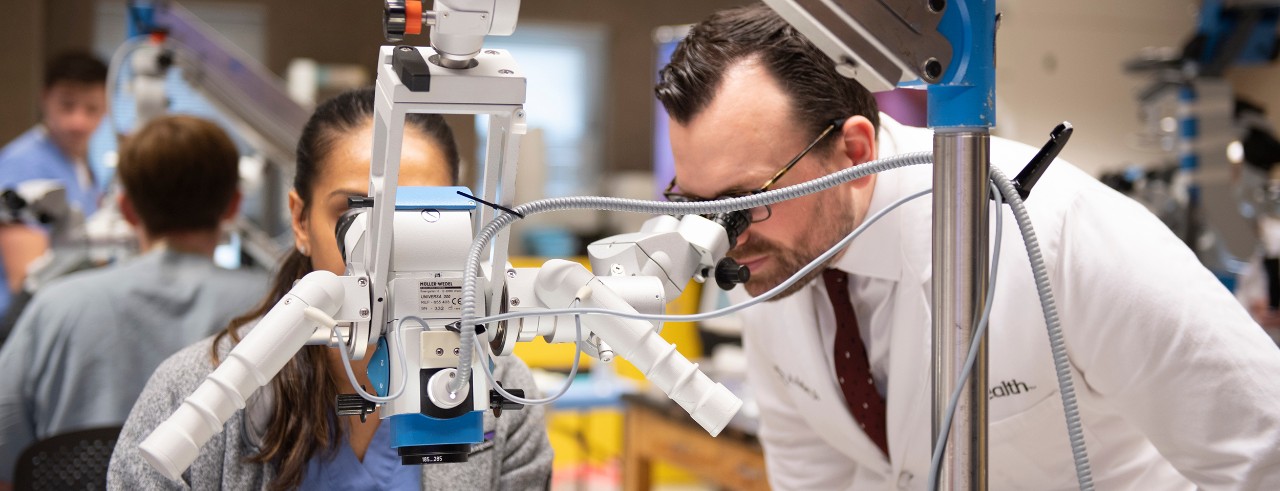
UC neurosurgery teaches technique on a micro level
Surgical residents from UC and other institutions practice microsurgery at the Goodyear Lab
Through high-powered microscopes, nearly a dozen surgical residents practiced stitching tiny sutures in the University of Cincinnati Goodyear Microsurgery Laboratory. It was part of a two-day course to learn and practice performing microvascular surgical techniques.
Mario Zuccarello, MD, a professor of neurosurgery, taught the intensive spring course at the UC College of Medicine along with Jonathan Forbes, MD, assistant professor of neurosurgery who oversees the Goodyear Lab. Zuccarello created the course several years ago and also travels to other universities to lead microsurgery courses.
Microsurgery involves the repair of small vessels, nerves and/or other tissues. These skills are used every day during brain surgery as neurosurgeons work closely on important structures such as blood vessels and nerves, says Zuccarello. “They are fundamental for surgeons who work under the microscope.”
“The objective is to provide hands-on training in microsurgical techniques in a progressive fashion through the course,” says Forbes. “We start the first day with suturing gauze, then plastic tubing and by the afternoon of the second day we practice on a rodent model.”

“This course allows you to use skills that you may already have but on a much finer level; the suture is smaller, the vessels are smaller, and your field is also smaller,” says Smruti Patel, MD, a resident physician in the Department of Neurosurgery.
Established in 1986, the Goodyear Lab is a premier teaching and research facility for residents, fellows, faculty, and practicing physicians. It provides a setting for neurosurgeons to learn and practice surgical anatomy and become skilled with microsurgical and endoscopic procedures including instrumentation.
“In a setting that is not in actual surgery, it allows us to practice our skills over and over again until we are comfortable,” Patel says. “It allows us to learn economy of motion when working in a small place, understand what kind of posture is necessary, and the ergonomics of surgery as well which is very important to consider in microsurgery.”
It’s technically demanding, says Zuccarello, because “you are working with tiny structures using small precision tools, all while looking through a microscope. It’s good practice for students to learn to carefully control their movements, or any natural tremors.”

In the Goodyear Lab, Mario Zuccarello, MD, professor of neurosurgery, speaks with Jonathan Forbes, MD, assistant professor.
Zuccarello and Forbes note that it takes both mental and physical training and endurance to learn and perfect the skills that will be needed as a neurosurgeon, and not something that everyone has the commitment to do.
Patel appreciates the chance to practice in the lab whenever she can. “As a resident, this experience is crucial to our training. Having the ability to practice my suturing technique outside of the operating room gives me the confidence to be able to appropriately assist and perform these tasks in surgery in a precise and timely fashion,” she says.
Residents and fellows can use the Goodyear Lab to simulate surgical procedures—both the standard and the most innovative—that they will ultimately perform in the operating room. The lab features six high-powered microscopes.
The lab also functions as a research facility to pursue investigative studies and test new procedures, particularly in the areas of complex intracranial surgery and skull base. Spaces like the Goodyear lab reflect UC’s commitment to innovation, as outlined in its strategic direction Next Lives Here.

Neurosurgical and other residents in surgical specialties attended the microsurgery course, including Patel and Brian Starr, MD, from UC, as well as residents from Mayo Clinic, Utah, University of Louisville, Ohio State, Missouri, Illinois and Wisconsin.
“This course has been invaluable to my surgical education,” says Patel. “I hope that it will continue to be offered every year so that my junior residents can also have the same experiences in the lab.”
Photos/Colleen Kelley/UC Creative Services
Next Lives Here
The University of Cincinnati is classified as a Research 1 institution by the Carnegie Commission and is ranked in the National Science Foundation's Top-35 public research universities. UC's graduate students and faculty investigate problems and innovate solutions with real-world impact. Next Lives Here.
Related Stories
Bazinga! UC physicist cracks ‘Big Bang Theory’ problem
December 19, 2025
A physicist at the University of Cincinnati and his colleagues figured out something two of America’s most famous fictional physicists couldn’t: theoretically how to produce subatomic particles called axions in fusion reactors.
Future Tech Forum tackles an AI-driven world
December 19, 2025
Cincinnati innovators and business leaders packed UC’s 1819 Innovation Hub in early December for the Future Tech Forum, where they considered the road ahead for AI.
Broad co-opportunities
December 18, 2025
Sakura Adachi exemplifies the Bearcat spirit: she works hard, she gives back and she takes full advantage of the opportunities the University of Cincinnati offers.
